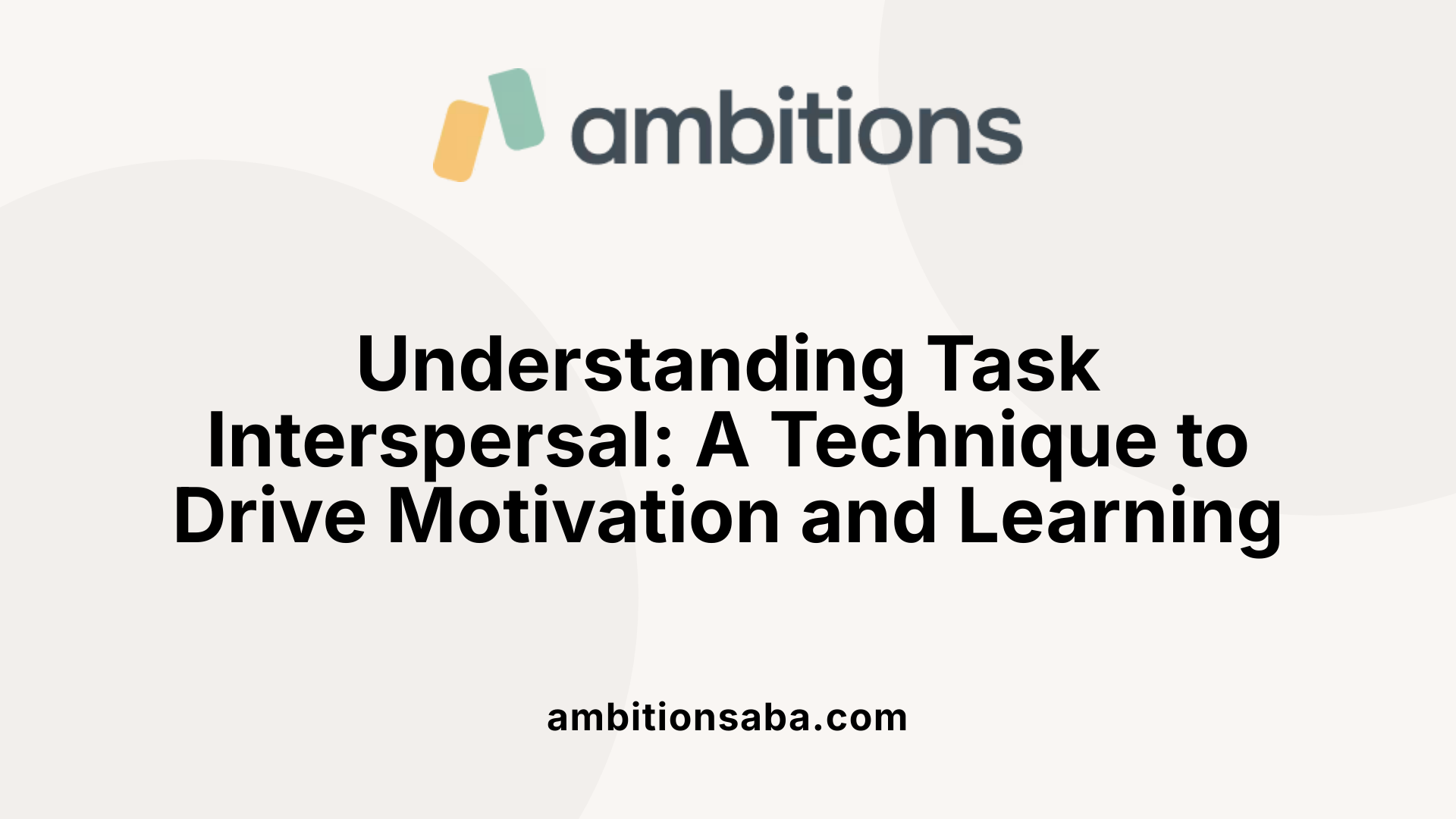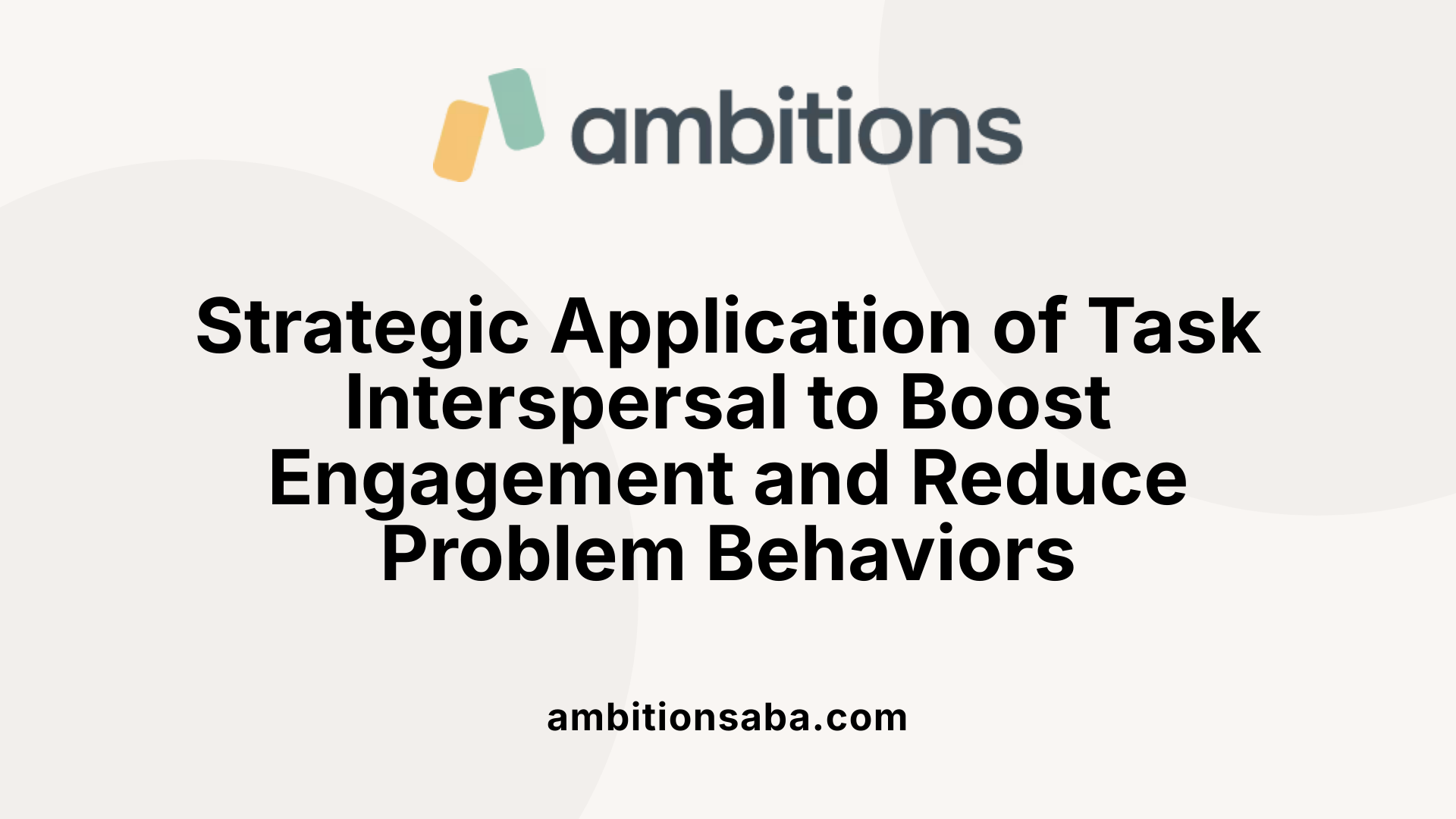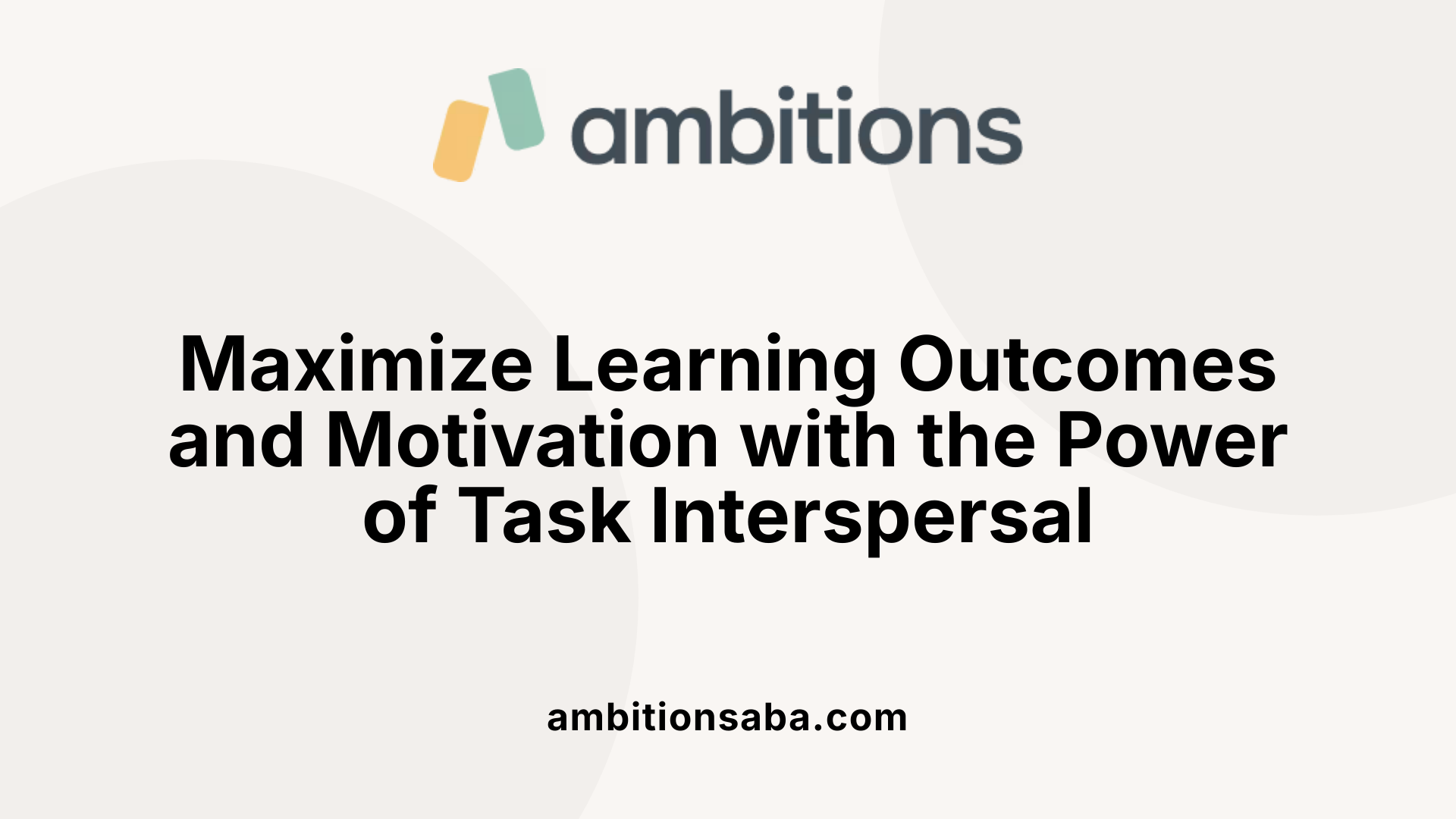Understanding the Basics of Task Interspersal
Task interspersal is an instructional strategy widely used in educational and behavioral contexts to improve learning outcomes and maintain student engagement. This method involves mixing or interleaving different tasks or behaviors at intervals, often blending mastered tasks with new or challenging targets. By doing so, it aims to create a motivating and dynamic learning environment that benefits skill acquisition, retention, and behavior management, especially for individuals with autism spectrum disorder (ASD). The concept derives directly from the term 'interspersal,' which refers to inserting one thing among others at intervals, emphasizing the importance of varied task sequencing in effective instruction.
What is Task Interspersal?

What is the meaning of task interspersal?
Task interspersal is a teaching technique that involves mixing or interleaving different tasks or behaviors at intervals to promote learning and motivation. It is derived from the noun "interspersal," which means the act of inserting or combining one thing among others at intervals. The core idea is to alternate between easier, mastered tasks and more challenging or unfamiliar tasks within a session.
The purpose of interspersing tasks is to create variety, sustain engagement, and support understanding by providing learners with a mix of different activities or stimuli. This approach leverages the natural tendency for learners to stay motivated when they experience frequent successes and when tasks are diversified.
In practical terms, task interspersal can be used by educators and therapists to boost learning outcomes by strategically placing familiar, mastered tasks among new or difficult tasks. This method helps prevent frustration, build confidence, and maintain motivation.
The role of interspersing mastered and acquisition tasks
A typical feature of task interspersal is the combination of maintenance (mastered) targets with acquisition (learning) targets. Mastered tasks are those the learner can perform with high accuracy, often highly preferred or brief, providing reinforcement and positive momentum.
These mastered tasks are interleaved with acquisition tasks—those that the learner is currently trying to learn or improve. The rationale is that the completed, mastered tasks serve as conditioned reinforcers and increase overall compliance and enthusiasm.
The ratio of interspersed tasks often reflects the individual learner's needs. Commonly, a 3:1 ratio—three mastered tasks for every one new task—is used, but variation exists based on the learner's responsiveness. Studies suggest that interspersing variation, especially with tasks of similar difficulty, promotes better response accuracy, enhances motivation, and reduces problem behaviors like noncompliance.
Applications across educational and behavioral settings
Task interspersal is widely applied in both educational and behavioral contexts, especially with individuals with autism spectrum disorder (ASD). It is an adaptable strategy suitable for various skills including math, spelling, sequencing, and labeling.
In classroom settings, teachers often mix easier or mastered academic tasks with more complex problems to keep students engaged and improve learning rates. For example, a teacher might alternate between simple addition problems that the student can do quickly and more challenging word problems.
In behavioral interventions, task interspersal is used to increase correct responding, promote on-task behavior, and reduce interfering behaviors. It has been effective across different populations and target skills, with research supporting its versatility.
Providers often decide on procedural variations based on organizational guidelines or clinical judgment rather than strict empirical protocols. While some individualization is common, consistency in methodology varies, highlighting the need for further research.
Overall, task interspersal facilitates learning by creating a motivationally rich environment where successful performance leads to positive reinforcement and sustained engagement. Its flexibility in implementation makes it a valuable tool for practitioners aiming to enhance educational and behavioral outcomes.
When is Task Interspersal Useful?

When is task interspersal useful?
Task interspersal is most effective in contexts where the primary goals are to accelerate learning, enhance motivation, and improve retention of skills. This technique is especially advantageous when working with individuals with autism spectrum disorder (ASD) or those who experience learning difficulties.
The method involves mixing easier, mastered tasks with more difficult, new, or less familiar tasks during instructional sessions. This variation helps maintain student engagement and motivation, as learners encounter a balanced mix of familiar success and new challenges.
Research indicates that using task interspersal with a ratio of around 1:3—meaning one task of a new or more difficult type interspersed with three mastered or easier tasks—is often most effective. This ratio can be adapted based on individual student needs, learning pace, and specific goals.
In practical terms, task interspersal is beneficial for teaching a wide array of skills, including motor activities, verbal responses, social interactions, and academic subjects like spelling, math, or sequencing. It creates a supportive learning environment by reducing frustration and decreasing problematic behaviors like noncompliance, aggression, or off-task behavior.
Furthermore, the technique promotes behavior momentum. By frequently engaging in simple or mastered tasks, students build confidence and compliance, making them more likely to participate actively in more challenging tasks. This positive cycle fosters a sense of achievement and encourages continued learning.
Another key benefit is that task interspersal can be implemented without additional reinforcement beyond standard procedures, relying instead on the natural reinforcement that occurs when tasks are successfully completed. Studies have shown that student motivation and engagement increase simply through the strategic mixture of tasks.
In summary, task interspersal proves particularly useful when educators aim to improve skill acquisition, sustain motivation, and manage behavioral challenges during instruction. Its flexibility allows customization to meet individual needs, making it a valuable tool in diverse educational and behavioral settings.
Application in Education and Behavior Strategies

How can task interspersal be applied in education and behavioral interventions?
Task interspersal is a versatile teaching method that involves mixing mastered or preferred tasks with less familiar or more difficult ones during lessons. This approach helps sustain student motivation and promotes faster skill acquisition. In practice, educators and therapists begin by collecting a pool of tasks. These typically include tasks the student has already mastered or finds highly engaging.
During a session, the teacher or clinician alternates these easy tasks with targeted learning activities. A common ratio applied is 1:3, meaning that for every one new or challenging task, three familiar or mastered tasks are included. This ratio supports a flow of positive responses, maintaining momentum even when facing difficult skills.
The procedure can be adapted based on the individual needs of each learner. For example, some students may benefit from more frequent interspersal of mastered tasks, while others might need different types of tasks to stay motivated. Although the empirical literature does not specify a one-size-fits-all method, clinical judgment and ongoing assessment guide the implementation.
Reinforcement strategies are often integrated to enhance effectiveness. For instance, providing praise, tokens, or preferred items after successful responses encourages continued engagement. Teachers may also use visual supports such as schedules or task strips to clearly delineate task order, helping students anticipate and understand what comes next, which supports independence.
Integration with reinforcement and visual supports
Reinforcement plays a crucial role in task interspersal, especially when used strategically. When mastering new skills, reinforcing responses with praise or preferred items boosts confidence and helps establish positive associations. In many cases, reinforcement is tailored to responses, offering more reinforcement for unmastered tasks to motivate effort.
Visual supports such as pictures, charts, or color-coded task cards can organize tasks efficiently and make the interspersal process transparent. These supports aid students in understanding task expectations and promote self-regulation.
In addition, behavioral momentum—using easy tasks to build energy for more difficult ones—is closely related and often incorporated into interspersal strategies.
Advantages in promoting positive behaviors and learning
Research consistently demonstrates that task interspersal offers numerous benefits. It enhances learning rates by reducing frustration and increasing the likelihood of correct responses, especially on challenging tasks. The strategy also fosters a positive attitude towards learning, as success in easier tasks boosts confidence.
Beyond academic skills, interspersal helps decrease problem behaviors such as noncompliance and aggression. By providing frequent opportunities for success, students are less likely to become frustrated or disengaged. Studies show improvements in on-task behavior, compliance, and overall motivation.
Additionally, task interspersal can be implemented without additional interventions, making it a practical and efficient tool for educators and therapists. Its flexibility allows it to be adapted across diverse settings, including classrooms, therapy sessions, and behavioral programs.
In summary, effective application of task interspersal involves careful task selection, appropriate ratios, reinforcement, and visual supports. When utilized thoughtfully, it promotes a more engaging, motivating, and successful learning environment for students with autism and other neurodevelopmental disorders.
Supporting Individuals with Autism Spectrum Disorder (ASD)

How does task interspersal improve acquisition and motivation?
Task interspersal is an instructional method that involves alternating between mastered tasks and new, challenging tasks during learning sessions. This approach helps in maintaining student motivation by making learning more engaging and less frustrating. For example, mixing easier, well-mastered problems with more difficult ones can create a flow where children experience success more frequently, boosting their confidence.
Research has shown that interspersing tasks of similar or varying difficulty of tasks facilitates faster learning with fewer trials. It also creates favorable behavior momentum, encouraging compliance and willingness to continue learning. The optimal ratio of known to new or challenging tasks typically ranges from 1:3 to 1:1, depending on the individual's needs and responses.
In addition to increasing motivation, task interspersal supports response acquisition by providing continuous reinforcement opportunities. By offering brief, highly preferred or mastered tasks, learners experience higher success rates and develop positive associations with learning activities. This, in turn, can lead to better retention of skills and enhanced engagement during training.
What is the empirical evidence supporting the use of task interspersal?
Multiple studies and meta-analyses have demonstrated the effectiveness of task interspersal across different skills and settings. For example, research involving children with autism spectrum disorder has shown that interspersing mastered tasks among acquisition tasks increases the percentage of correct responses and accelerates learning. One study using a multiple-baseline design across three children illustrated that their accuracy improved systematically when task interspersal was implemented, and these gains were maintained even when reinforcement density was reduced.
Further investigations reveal that interspersal leads to reductions in problematic behaviors such as noncompliance and aggression, while increasing enthusiasm and positive affect. Studies comparing constant task presentation, varied task presentation, and interspersal consistently find the latter to be superior in fostering compliance and motivation.
Importantly, the benefits of task interspersal have been observed without additional interventions; simply embedding mastered tasks among new tasks can foster significant improvements, underscoring its efficiency and robustness.
How can task interspersal be customized based on individual needs?
Although the general principles of task interspersal are well-supported, implementation requires careful individualization. Practitioners often rely on clinical judgment and organizational guidelines to decide procedural variations, including the ratio of mastered to acquisition tasks and reinforcement schedules.
Individuals with autism may vary in their response to interspersal based on their skill levels, motivation, and behavioral characteristics. For some, a higher ratio of mastered tasks (e.g., 3:1) may boost confidence and compliance, while others may benefit from more frequent interspersed challenges (e.g., 1:1). Empirical assessments prior to intervention can help determine mastery levels and tailor task selection.
Reinforcement strategies should also be individualized, using preferred stimuli or reinforcement schedules aligned with each learner's motivation. Some learners may respond well to tangible reinforcers, while others benefit from social praise or activity-based reinforcers.
Ultimately, effective use of task interspersal involves ongoing monitoring and adjusting procedures, including the type and difficulty of tasks, reinforcement methods, and interspersal ratios, to meet each learner's evolving needs.
| Aspect | Typical Approach | Individual Considerations |
|---|---|---|
| Task selection | Mastered tasks mixed with new tasks | Skill levels, preferences, specific challenges |
| Interspersal ratio | Usually 1:3 to 1:1 | Motivation levels, response accuracy, behavioral needs |
| Reinforcement strategy | Varies, often preferred stimuli | Reinforcer effectiveness, learner's response history |
| Customization process | Empirical assessment, clinical judgment | Ongoing data collection, flexible adjustments |
In summary, while the core principles of task interspersal are evidence-based, its successful application depends on careful individualization guided by ongoing assessment and clinical insights.
Research and Scientific Evidence
What is the research basis for the effectiveness of task interspersal?
The foundation of empirical research strongly supports the use of task interspersal as an effective teaching method, especially for individuals with autism spectrum disorder (ASD). Multiple studies have demonstrated that interspersing mastered (maintenance) tasks with new (acquisition) tasks can significantly enhance learning outcomes, increase motivation, and promote skill retention.
Research employing rigorous designs, such as multiple-baseline studies across children with autism, shows that incorporating task interspersal leads to increased correct responses on target skills and maintains these gains even when reinforcement density is lowered. For example, one study observed that introducing interspersal procedures increased the percentage of correct responses to non-mastered matching-to-sample stimuli, with performance improvements persisting after reinforcement levels returned to baseline.
Designs used in studies (e.g., multiple baseline)
Most research utilizes the multiple-baseline design across participants, which involves systematically introducing the intervention at different times for different subjects. This design helps establish a clear causal relationship between the task interspersal procedure and observed improvements in responses.
Other common approaches include pre- and post-intervention assessments, comparing baseline phases with interspersal phases, and variations in reinforcement schedules to analyze their impact on learning and behavior. These studies often assess outcomes such as accuracy, response latency, problem behaviors, and engagement levels.
Key outcomes and implications
Overall, the evidence consistently indicates that task interspersal enhances several aspects of learning and behavior:
- Improved Skill Acquisition: Students demonstrate faster learning and higher accuracy, particularly with non-mastered skills.
- Skill Retention: Gains from interspersal are maintained over time, even with reduced reinforcement, suggesting strong durability of learned behaviors.
- Increased Motivation and Engagement: Interspersing tasks prevents boredom, sustains attention, and increases the likelihood of staying on-task.
- Reduction in Problem Behaviors: Noncompliance, aggression, and other interfering behaviors tend to decrease when students are engaged with preferred and mastered tasks.
While procedural variations are common, no specific method has shown clear superiority over others, implying that practitioners can adapt interleaving strategies to individual needs. Nonetheless, the accumulated scientific evidence underscores that task interspersal, grounded in behavioral principles, is a beneficial and evidence-based practice that effectively supports skill learning and behavioral improvement in children with ASD and other neurodevelopmental disorders.
| Study Design | Focus Area | Main Finding | Implication |
|---|---|---|---|
| Multiple-baseline | Matching-to-sample | Increased correct responses with interspersal | Supports causal link between interspersal and learning |
| Comparative | Reinforcement schedules | Variable effects; no procedure consistently superior | Flexibility and individualization recommended |
| Experimental | Skill retention | Maintained improvements despite lower reinforcement | Effectiveness in sustaining skills over time |
| Behavioral | Problem behaviors | Reduction observed, but limited overall impact | Interspersal can support positive behavior |
Research and practical application of task interspersal continue to evolve, strengthening its role as an evidence-based approach in education and behavioral therapy.
How Does Task Interspersal Improve Learning Efficiency?
How does task interspersal contribute to improving learning efficiency?
Task interspersal enhances learning efficiency primarily by maintaining student motivation and engagement during instructional sessions. This method involves mixing tasks that are already mastered or preferred with new, more challenging tasks. Such a blend keeps students interested and reduces boredom, which can hinder learning.
Research shows that inserting easier, well-mastered tasks among complex or unfamiliar tasks creates a supportive environment that fosters positive feelings and confidence. When children with autism spectrum disorder (ASD) are presented with familiar or highly preferred tasks, they are more likely to stay engaged and respond correctly to new stimuli.
Furthermore, this approach can help lower frustration levels. If students encounter difficulty on a new task, the presence of easier tasks provides opportunities for success, preserving motivation and reducing behavioral issues like noncompliance or aggression. The strategic use of maintenance tasks (known skills) with acquisition tasks (learning new skills) creates a steady momentum for learning.
Implementing task interspersal has also been associated with improved retention of skills. Repeatedly practicing mastered tasks alongside new ones strengthens existing skills while facilitating the acquisition of new skills. This balance speeds up response acquisition and makes the overall learning process more efficient.
Effects on motivation and reducing frustration
Motivation is a crucial factor in effective learning, especially for children with ASD, who may become easily frustrated or disengaged. Task interspersal leverages the concept of behavioral momentum by starting with manageable, familiar tasks and gradually introducing more challenging ones.
By frequently experiencing success, students develop confidence, which encourages continued participation. The method also helps prevent burnout or negative emotional responses during learning, leading to more positive attitudes toward educational tasks.
In addition, because the tasks of varying difficulty are mixed, students are less likely to feel overwhelmed. This reduces stress and decreases problem behaviors like noncompliance, aggression, or task refusal.
Optimal ratios and individual considerations
Most practitioners report using a 3:1 ratio of maintenance to acquisition tasks, which aligns with common practices cited in research. This means providing three mastered or preferred tasks for every one new or challenging task.
However, the ideal ratio is often student-specific. Some individuals may benefit from more frequent exposure to mastered tasks, while others might require more balanced or varied proportions. Recent studies suggest that interspersing tasks of similar difficulty is common, but combining tasks of varying difficulty can yield better results.
Practitioners often rely on clinical judgment, organizational guidelines, and individual client characteristics to tailor the interspersal procedure. While the empirical literature does not prescribe rigid ratios, adjusting the number of mastered or familiar tasks based on student response, motivation, and progress can optimize learning outcomes.
In conclusion, task interspersal improves learning efficiency by creating a motivating, low-stress environment that promotes skill acquisition and retention. Its flexible, strategic implementation supports sustained engagement, reduces frustration, and accelerates the mastery of new skills in children with ASD.
Example in Applied Behavior Analysis (ABA)
How is task interspersal applied in ABA settings?
In applied behavior analysis (ABA), task interspersal is frequently used to improve learning outcomes and maintain motivation among individuals with autism spectrum disorder (ASD). One common example involves blending mastered skills with new or more challenging tasks during therapy sessions.
For example, a therapist might have a child practice a well-learned skill, such as requesting an object or favor, and then quickly switch to working on a more difficult skill, like independent reading or complex sequencing. This mixture keeps the child engaged, boosts confidence, and reduces the likelihood of frustration.
During a session, the therapist might intersperse a ratio of three mastered tasks for every one new or difficult task, which aligns with typical practice and supports motivation. This approach ensures that the learner experiences success frequently, which can foster positive affect and further reinforce the learning process.
Moreover, task interspersal can facilitate generalization of skills across different settings and contexts by varying task demands dynamically. It also promotes optimal response rates and reduces behaviors like noncompliance or aggression by making sessions more varied and manageable.
Overall, this technique demonstrates how carefully combining easier and more complex tasks within a session can maximize engagement, enhance learning efficiency, and support the development of new skills in children with ASD.
Conclusion: The Benefits of Task Interspersal

What is the overall benefit of using task interspersal?
Task interspersal is an instructional method that involves mixing mastered tasks with new or challenging tasks during teaching sessions. Its primary advantage lies in enhancing learning efficiency by maintaining student motivation and engagement. Research consistently shows that by interlacing these tasks, students tend to exhibit increased participation, improved response accuracy, and greater confidence.
This approach is particularly effective for individuals with autism spectrum disorder (ASD), often resulting in reduced problematic behaviors such as noncompliance and aggression. Empirical studies support that interspersal not only promotes skill acquisition but also boosts positive affect and overall enjoyment of learning activities.
Practitioners employ various procedural modifications depending on organizational guidelines and clinical judgment. Still, the core concept remains the same: alternating easier, mastered tasks with more difficult ones to sustain motivation and foster learning.
Most studies report using a 3:1 ratio, where multiple familiar or mastered tasks are presented between target tasks, although the optimal ratio may vary based on individual student needs. The versatility of the method allows it to be adapted across diverse skills, including academic subjects like math, spelling, and sequencing.
Additionally, the method aligns with behavioral principles such as conditioned reinforcement and behavioral momentum. Reinforcement strategies are often tailored to responses, with more reinforcement provided for unlearned tasks to stimulate effort.
The overall benefit of task interspersal is its ability to create a positive learning environment that supports faster acquisition, retention, and generalization of skills. It helps maintain learners' motivation, reduces frustration, and increases overall satisfaction with learning experiences.
While procedural variations exist, no single approach has proven superior, indicating that the method's flexibility allows customization to fit specific educational contexts.
In summary, task interspersal offers a scientifically supported, adaptable, and effective strategy for improving educational outcomes for individuals with ASD and beyond. Its focus on balancing challenge and mastery encourages consistent progress, making it a valuable component of comprehensive instructional approaches.
Summing Up the Strategic Value of Task Interspersal
In conclusion, task interspersal is a versatile, evidence-based teaching method that effectively promotes skill acquisition, motivation, and positive behavior. Its adaptability across settings, populations, and skill domains makes it a powerful tool in both educational and therapeutic contexts. As research continues to evolve, understanding the specific procedures and optimal ratios for individual learners will further enhance its application, ensuring that task interspersal remains a cornerstone of effective instructional design.
References
- Task Interspersal Implementation Practices with Individuals with ...
- Sage Reference - Task Interspersal
- Task interspersal and performance of matching ... - ScienceDirect.com
- "Too Much Reinforcement, Too Little Behavior: Assessing Task ...
- Task interspersal for individuals with autism and other ...
- Task Interspersal: a Meta-Analytic Review of Effective Programming
- [PDF] WHY IS IT INTERSPERSING TASKS - AWS
- Task Interspersal Implementation Practices with Individuals with ...
- Activity Sequencing - MoEdu-SAIL
- Task Interspersal: a Meta-Analytic Review of Effective Programming



